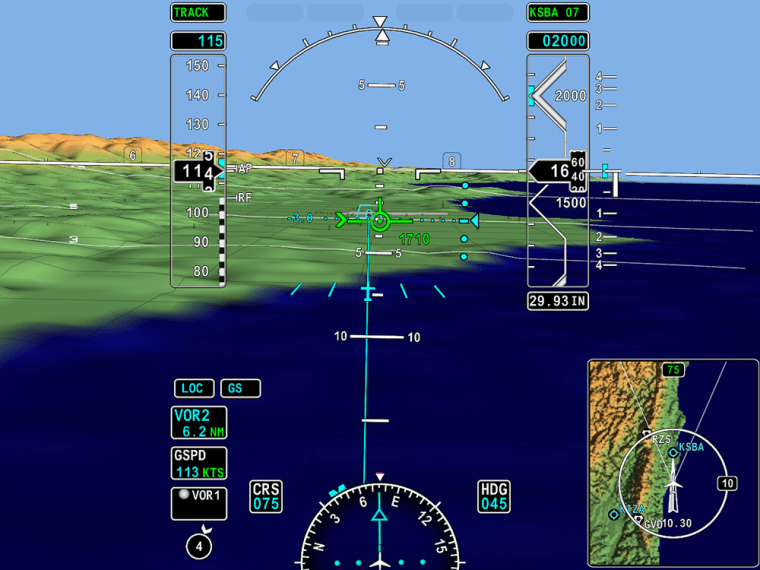Nail-biting blind landings in foul weather may soon be a lot less perilous, thanks to a new corporate jet technology that could also find its way into airliner cockpits.
At the Farnborough Airshow, Gulfstream became the first executive plane maker to offer the system, which displays a computer-generated view of the terrain ahead — even in heavy fog or cloud, when the ground can be invisible to the most advanced infra-red sensors.
Gulfstream Aerospace Corp. claimed that the so-called Synthetic Vision System, or SVS, will result in "more accurate tactical flight decisions by pilots and ultimately increased safety."
The Honeywell equipment chosen by Gulfstream is a highly detailed, three-dimensional satellite navigation display for planes. Without SVS, satellite navigation already enables pilots to pinpoint their position and avoid some hazards — but not to carry out landing approaches or other precision maneuvers in low visibility.
Instead of the traditional blue-over-brown artificial horizon, a pilot using the new display sees an ever-changing virtual view from the cockpit — overlaid with the familiar altitude, attitude, speed and heading indicators.
Despite appearances, it is nothing like a video game, Honeywell Vice President Robert Smith said in an interview. "This is not Microsoft Flight Simulator."
The software draws on an extensive global database of runways and obstacles, superimposed on global terrain mapping data gathered by the space shuttle Endeavor in a February 2000 radar survey of Earth's surface.
Like in-car systems, it can also incorporate real-time traffic information from other sources, flashing up collision-avoidance warnings when planes are nearby or when the runway ahead is already in use.
Gulfstream expects to get the required certification from the U.S. Federal Aviation Administration in 2007. Spokesman Robert Baugniet declined to give any information on the pricing of the system — to be sold as an optional upgrade to the company's G350, G450, G500 and G550 business jets.
The FAA initially had reservations about the safety of SVS displays, but has come to see the benefits, officials say.
"They could potentially reduce accidents of the type that often happen in bad weather, at night or in limited visibility," FAA spokeswoman Alison Duquette said.
Bad weather is often a factor in the loss-of-control incidents that were responsible for 91 percent of fatal air accidents in 2005, according to the administration's figures.
Nevertheless, there are still concerns that in some situations, pilots could be lulled into a false sense of security by the SVS — which does not itself detect potential obstacles in a plane's path, such as other aircraft or runway obstructions.
"Synthetic Vision may be so compelling that pilots try to use it beyond the intended function," the FAA cautioned in December 2005 guidelines.
But experts predict the technology will save lives, particularly during low-visibility landings at smaller airports without state-of-the-art instrument landing systems — or those where mountains or other obstacles force pilots to follow difficult approach paths.
"It enables you to fly very much more accurately for the sector of the approach on which most aircraft are lost during non-precision landings," said David Learmount, operations and safety editor with London-based Flight International.
"It's absolutely brilliant for business jets — the whole idea of a business jet is to be able to fly safely to any airfield you like, including small regional airports."
The airports served by airlines typically already have sophisticated instrument landing systems that guide passenger jets in to land at night and in low visibility.
Nevertheless, Honeywell and its competitors were hoping SVS will eventually catch on with commercial carriers.
Advocates say the technology could help avoid accidents such as the 1997 crash in Guam, when a Korean Air 747 plowed into a rocky hillside while attempting to land in rain, killing 228 people. A report concluded that problems with the airport's low-altitude warning device may have been a factor.
"We've talked to virtually everyone," Honeywell's Smith said. "They're certainly looking at these systems."
SVS could appear in airliners around 2012-2014, he said, declining to elaborate on discussions with other aircraft makers and airlines.
Rockwell Collins Inc., another U.S. avionics maker, is developing its own SVS displays and also expects demand from airlines and from another of its regular customers — the U.S. Air Force.
"We also see military applications," company spokesman Nancy Welsh said. "Imagine you're flying in a brown-out (thick dust cloud) in Iraq. Synthetic vision might be quite useful."
